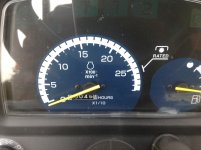Catman8
Gold Member
Hello JD owners, this is my first tractor I've owned with a hydrostatic transmission and need some advice. How do you know what is the correct RPM to select without wasting fuel or under powering the engine.

The gauge says rated 2500 RPM. does this mean that any time you are using a PTO implement that the RPM's have to be at 2500.
Let's say I have a full bucket of dirt and I am traveling along a flat paved road can I choose any RPM's I want, when do you know if your over revving the rpm's and wasting fuel or under revving the rpm's and putting a strain on the engine if there is such a thing. Thanks in advance.

The gauge says rated 2500 RPM. does this mean that any time you are using a PTO implement that the RPM's have to be at 2500.
Let's say I have a full bucket of dirt and I am traveling along a flat paved road can I choose any RPM's I want, when do you know if your over revving the rpm's and wasting fuel or under revving the rpm's and putting a strain on the engine if there is such a thing. Thanks in advance.
